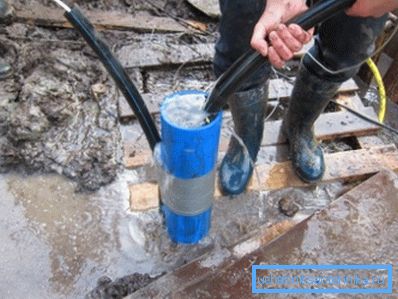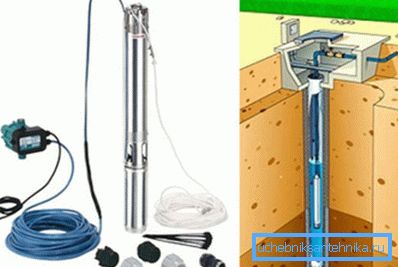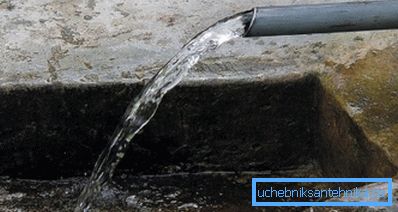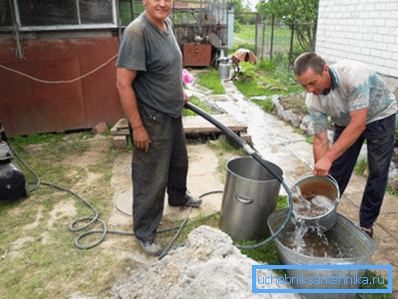How to pump a well: tips for beginners
Information on how to pump a well with your own hands, is very popular. The fact is that the work associated with the well water supply is quite expensive in itself, and if you also pay for professional pumping, the amount will turn out to be indecent.
So many are trying to do this work on their own, especially since this is a completely feasible task.

Characteristics of the buildup process
First of all, we need to understand what the described process is.
Traditionally, pumping (or pumping) is a procedure in which a well is cleaned after drilling and prepared for further operation. This is due to the fact that immediately after the execution of work in the selected cavity, a completely non-crystalline liquid appears. Raised water contains a large number of suspended particles, and only by special operations their content can be reduced to an acceptable level..

Note! If, after drilling, no steps are taken, rather soon the drilled well will be fully silted and cease to function. Restore its performance is very expensive, because you should not let the process take its course.
The cleaning process takes place in several stages:
- Immediately after the start of pumping a turbid liquid flows from the well, which is suitable only for some technical needs.
- Over time (from several hours to several weeks depending on the soil conditions) the liquid is clarified.
Note! The longest is the process takes place on clay soils. It may take up to one and a half months to completely remove suspended fine particles from an aquifer.
- As a result, the pump begins to deliver clean water. This process can be considered complete.
Description of technology
Equipment selection
Any instruction for self-preparation of an aquifer well for operation begins with a description of the equipment used.
Our article will not be an exception:
- For supplying water for domestic use, a high-quality well pump is required. In principle, it can be used for our task, but the high price of such equipment makes such an approach unreasonable. Passing through the water suspension of solid parts, if the device does not break, it will wear out a lot, and by the beginning of operation it will be practically unsuitable for work.

- The best way out of this situation would be to buy an inexpensive submersible pump specifically for pumping. Of course, in the process of cleaning a well a cheap model will stick a couple of times, but it will cope with the main task.
Note! On clay soils, you may need at least two devices: one pump performs a buildup, the second is under repair.
- Choosing which pump to pump the well, it is worthwhile to dwell on the use of centrifugal types of devices. The thing is that the vibration models with such a load can work for very short periods, so they will need to be changed often, and this is clearly extra costs.
Installation of the pumping system
In order for the buildup process to proceed as efficiently as possible, our pump must be properly suspended:
- The device is located at a distance of about half a meter from the bottom of the well (as a rule, this coincides with the level of a gravel filter).
- For hanging use a cable or a special halyard mounted on a shock absorber made of a durable rubber rope.

Tip! During the work there is a risk of the pump getting into the oozy layer. It is for pulling the stuck device and we need a very strong suspension.
- In the process of operation, the pump should actively capture silt particles from the bottom layer. If this does not happen, you need to adjust the installation position.
- To prevent the equipment from breaking down less frequently, we periodically take out the device and wash all moving parts under running water, removing accumulated clay particles. Of course, this will reduce the speed of work, but it will be possible to save on the purchase of a new pump instead of a burnt one.
Pumping process
So, what should be done to complete the preparation for the work yourself?
The scheme of action is quite simple:
- Install the pump according to the algorithm given in the previous section.
Tip! Before pumping the Abyssinian well (the so-called well-needle), it is necessary to install a check valve that will provide unidirectional movement of the water flow.
- We connect the pump and begin the active pumping. Muddy water will begin to leave the well (or air first, and therefore water - this happens when working with sealed systems).

- Water with suspended clay particles should be drained into a special ditch. As a rule, the volume is poured large, and therefore the ditch for drainage should be appropriate.
- To optimize the process, you can make a sand trap. It is a large barrel or a plastic container with two taps: the top one is for supplying water, and it is fixed approximately in the middle of the height for discharge.
- When contaminated water enters the sand trap, the particles settle at the bottom, and an almost pure liquid comes out through the drain valve. Of course, you should not drink it - but it is quite suitable for technical needs.

Prevention
After all the work is done, the installation can be operated normally, replacing the temporary pump with a stationary well pump.
Wherein:
- In the summer, a large flow of water for irrigation or filling the pool contributes to automatic pumping.
- In winter, you also should not leave a well without attention. It is advisable to turn it on for washing at least once every two weeks for an hour and a half. Otherwise, until the spring at the bottom of the formed muddy plug, which will have to be washed out under high pressure.
- Also, at least once every three to four years, it is worth removing the pump and carrying out its preventive maintenance. At the same time, it is possible to carry out a control washing of the lower horizons, removing accumulated clay particles.

Conclusion
Starting to equip the source of underground water supply, it is necessary to study in advance how to pump a well well and how to deal with its silting. This information will help you avoid a lot of problems in the future, as well as provide an opportunity to significantly reduce costs. In more detail, this topic is described in the video in this article, so do not be limited to textual materials only!